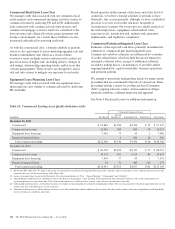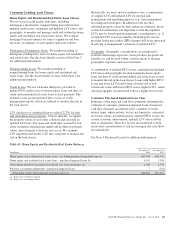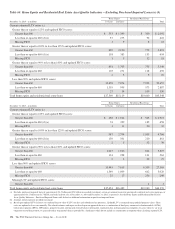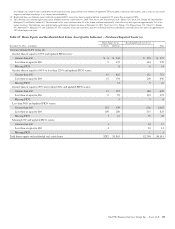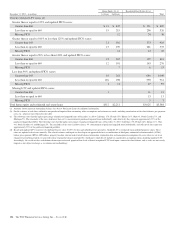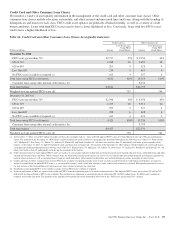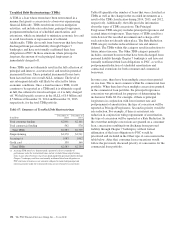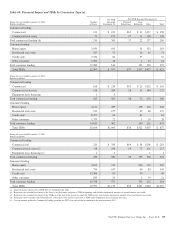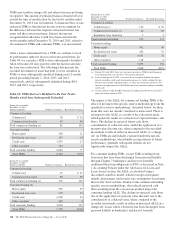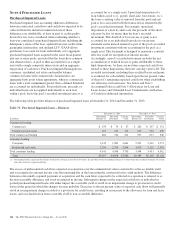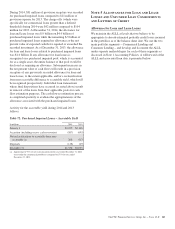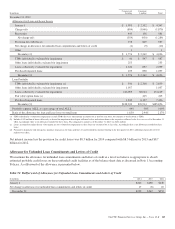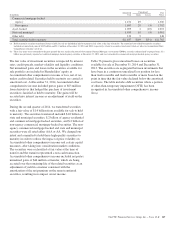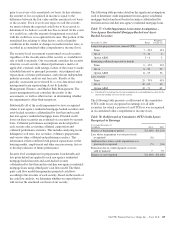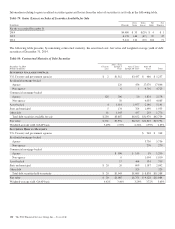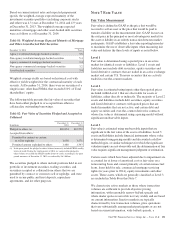PNC Bank 2014 Annual Report Download - page 160
Download and view the complete annual report
Please find page 160 of the 2014 PNC Bank annual report below. You can navigate through the pages in the report by either clicking on the pages listed below, or by using the keyword search tool below to find specific information within the annual report.
N
OTE
4P
URCHASED
L
OANS
Purchased Impaired Loans
Purchased impaired loan accounting addresses differences
between contractual cash flows and cash flows expected to be
collected from the initial investment in loans if those
differences are attributable, at least in part, to credit quality.
Several factors were considered when evaluating whether a
loan was considered a purchased impaired loan, including the
delinquency status of the loan, updated borrower credit status,
geographic information, and updated LTV. GAAP allows
purchasers to account for loans individually or to aggregate
purchased impaired loans acquired in the same fiscal quarter
into one or more pools, provided that the loans have common
risk characteristics. A pool is then accounted for as a single
asset with a single composite interest rate and an aggregate
expectation of cash flows. Purchased impaired homogeneous
consumer, residential real estate and smaller balance
commercial loans with common risk characteristics are
aggregated into pools where appropriate, whereas commercial
loans with a total commitment greater than a defined threshold
are accounted for individually. For pooled loans, proceeds of
individual loans are not applied individually to each loan
within a pool, but to the pool’s recorded investment since it is
accounted for as a single asset. Upon final disposition of a
loan within a pool (e.g., payoff, short-sale, foreclosure, etc.),
the loan’s carrying value is removed from the pool and any
gain or loss associated with the transaction is retained in the
pool’s recorded investment. For example, upon final
disposition of a loan by short-sale, the proceeds of the short-
sale may be less (or more) than the loan’s recorded
investment. This shortfall or loss (excess or gain) is not
accounted for as an individual loan sale in our income
statement and is instead retained as part of the pool’s recorded
investment consistent with our accounting for the pool as a
single asset. This treatment is designed to maintain a constant
effective yield for recognition of interest income.
Accordingly, a pool’s recorded investment includes the net
accumulation of realized losses or gains attributable to these
final dispositions. As there are no future expected cash flows
related to these dispositions, their net carrying value is $0. The
recorded investment, including these realized losses and gains,
is evaluated for collectability based upon the net present value
of the pool’s remaining expected cash flows when establishing
our allowance for loan losses. See below and Note 1
Accounting Policies and Note 5 Allowances for Loan and
Lease Losses and Unfunded Loan Commitments and Letters
of Credit for additional information.
The following table provides balances of purchased impaired loans at December 31, 2014 and December 31, 2013:
Table 71: Purchased Impaired Loans – Balances
December 31, 2014 December 31, 2013
In millions
Outstanding
Balance (a)
Recorded
Investment
Carrying
Value
Outstanding
Balance (a)
Recorded
Investment
Carrying
Value
Commercial lending
Commercial $ 159 $ 74 $ 57 $ 282 $ 157 $ 131
Commercial real estate 307 236 174 655 516 409
Total commercial lending 466 310 231 937 673 540
Consumer lending
Consumer 2,145 1,989 1,661 2,523 2,312 1,971
Residential real estate 2,396 2,559 2,094 3,025 3,121 2,591
Total consumer lending 4,541 4,548 3,755 5,548 5,433 4,562
Total $5,007 $4,858 $3,986 $6,485 $6,106 $5,102
(a) Outstanding balance represents the balance on the loan servicing system for active loans. It is possible for the outstanding balance to be lower than the recorded investment for certain
loans due to the use of pool accounting.
The excess of undiscounted cash flows expected at acquisition over the estimated fair value is referred to as the accretable yield
and is recognized as interest income over the remaining life of the loan using the constant effective yield method. The difference
between contractually required payments at acquisition and the cash flows expected to be collected at acquisition is referred to as
the non-accretable difference and is not recognized in income. Subsequent changes in the expected cash flows of individual or
pooled purchased impaired loans will either impact the accretable yield or result in an impairment charge to provision for credit
losses in the period in which the changes become probable. Decreases to the net present value of expected cash flows will generally
result in an impairment charge recorded as a provision for credit losses, resulting in an increase to the allowance for loan and lease
losses, and a reclassification from accretable yield to non-accretable difference.
142 The PNC Financial Services Group, Inc. – Form 10-K


